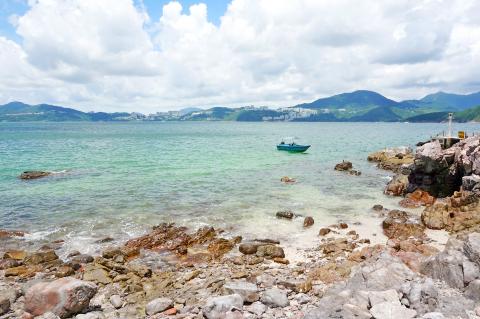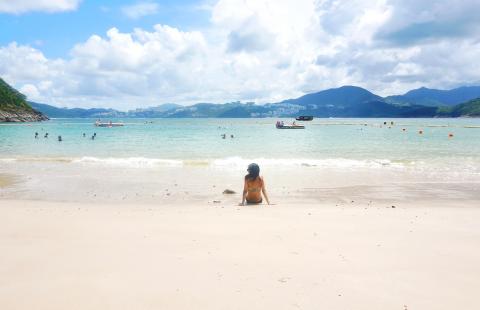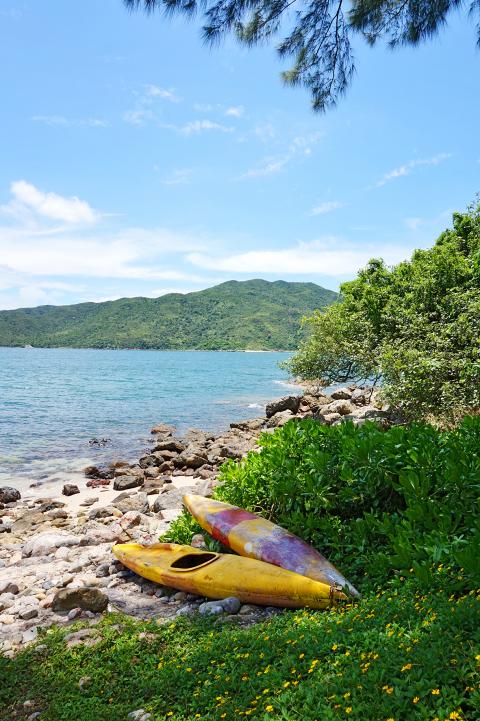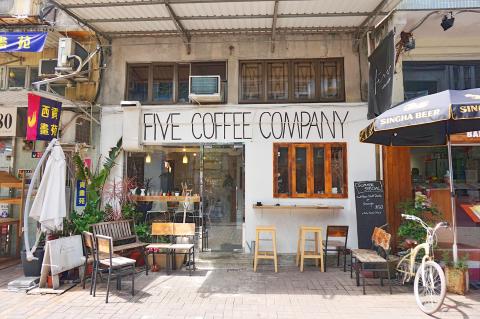When my family lived in Hong Kong in the early to mid-90s, I developed a knack for seeking out playgrounds that were shrouded with lots of trees. My mother tells me that I even refused to be interviewed by a kindergarten because their campus barely had any foliage. Some people thrive on the energy of concrete jungles; I’ve always been drawn to real ones.
I was staying in the hectic business district of Admiralty during a recent visit when I started to feel suffocated by the city. I remembered my mother saying that the company my grand uncle worked for, Binnie & Partners, had helped build High Island Reservoir (萬宜水庫) in Sai Kung District (西貢), out in the New Territories, in the 70s. There are clean beaches there, she said, and hiking trails.
I decide on a day trip and drag my friend — who is Hong Kong born and bred and very averse to outdoor activities — along for the ride.

Photo: Dana Ter, Taipei Times
We watch the scenery outside the minibus we caught from Choi Hung MTR (彩虹) unfold as we zigzag through winding mountain roads and dip into valleys, the squeaky clean skyscrapers giving way to graying, dilapidated apartment buildings.
Disembarking at Sai Kung Town, I notice an organic grocery store and another selling French wines. Surrounding them are ramshackle, low-rise residential buildings and small shops selling fruits, birdcages and household supplies. There’s also a vintage clothing place and a ceramics shop with a sign on the door advertising pottery lessons.
Making our way out of the maze of businesses, we find ourselves at the pier. This is where the fishermen’s boats and water taxis are docked. Numerous seafood restaurants with fish tanks displaying the catch of the day line the dock. In the distance are multi-story houses peeking through mountains. I ask my friend about them and she shakes her head.

Photo: Dana Ter, Taipei Times
“They’re expensive,” she says. “Most people our age can’t afford the rent there.”
FISHERMAN’S COVE
The rest of Sai Kung is a country park with lush hills, golf courses and idyllic coves and bays, with the reservoir sitting on the south end. Without a car — or your own jet ski or kayak — the only way to the beaches is by hiking or the water taxis, which are controlled by a handful of vendors operating at the pier. They advertise various destinations — Tai Long Wan (大浪灣), Half Moon Bay (半月灣) — though mostly in Chinese. And, no surprise here, you’ll have to bargain a fair bit, so it helps to go with someone who speaks Cantonese.

Photo: Dana Ter, Taipei Times
I wanted to check out the surf at Tai Long Wan, which means “Big Wave Bay,” after reading a recent article in the South China Morning Post about the history of local surf culture. Unfortunately, the water taxis did not run there frequently. Instead, we settled on Half Moon Bay on Sharp Island (橋咀洲), the closest island to Sai Kung. It also resonated better with my friend since there were lifeguards there — not that it mattered to me, as I regularly surf unattended beaches in Taiwan.
The 20-minute boat ride is a pleasant experience. We went on a clear day with gentle waves, and our time was occupied gazing out into the turquoise waters and islands too small and untamed for people to inhabit. I found myself wishing that I had my own jet ski to explore with. Despite a few unpleasantries that I rarely see at Taiwan’s beaches — buoys mark where you can and cannot swim and a rather unsightly public bath and restroom sits literally a couple meters from the sand — the main beach at Half Moon Bay is a gorgeous sight with long stretches of white sand and warm waters for swimming.
Of course, we stray away from the main area where all the visitors are and wander to a concealed cove. Two battered-down canoes had washed ashore, and we are immediately awestruck by the serenity. Climbing over rocks, we make our way to the shore. Surrounding us is calm, light turquoise water. We’re soon joined by a fisherman, cigarette dangling from his mouth. Oblivious to the bewilderment of two city slickers, he plops himself down on a rock, removes his rubber boots and starts filing his toenails. He has the right idea, I think to myself.

Photo: Dana Ter, Taipei Times
SEAFOOD SANCTUARY
To my dismay, we don’t have time to visit the reservoir. We spend the remainder of the afternoon back at the pier, which isn’t too bad if you have a half-kilogram of fresh clams on a plate to yourself. There’s a devoted seafood street — it’s actually called Seafood Street (海鮮街) — where diners sample fresh lobster, crab, clams and what not.
It takes some wandering and asking around before arriving at the restaurant we’re looking for, the one Michelin star Sing Kee Seafood Restaurant (勝記海鮮酒家), housed in a three-story building painted in hot pink and beige-orange. The restaurant is deserving of its Michelin star rating. Chewy and flavorful, the clams with glass noodles are my favorite dish. The steamed prawns and salt and pepper squid are other fine options, though even the non-seafood dishes, including the braised tofu and beef with flat rice noodles, are delicate and refined.
That being said, you won’t go hungry in Sai Kung. Close to Sing Kee is Five Coffee Company, a highly Instagrammable coffee joint with potted plants and little wooden chairs. There’s also a Sri Lankan eatery and a Caribbean bar and restaurant. Let’s Jam (一起果醬) serves afternoon tea with homemade jams on the ground floor of an old, three-story residential building. Opposite the street, another shop dries their salted fish on trays that lay atop worn-out tables under the sun. For liquor, check out the French wine shop Epicerie, or The Bottle Shop.
On our way back to the minibus station, we stumble across a hanging garden filled with tropical pitcher plants, also known as monkey cups. The reddish-green sacks which dangle from the tips of leaves trap insects, mostly flies. It looks like the residents have also taken to growing their own greenery here, with money plants wrapping around metal poles. I guess I’m not the only person in Hong Kong who likes trees.
In less than an hour, we’re back in Admiralty, and I’m off to dinner at a fine dining Thai restaurant with my family after a quick shower, the beach still on my mind. Next time, I’ll weather the mountain trek to Tai Long Wan and catch a few waves. I hear it’s better during winter, anyways.
PACK YOUR BAGS
Getting there
- Eva Air and Cathay Pacific fly multiple times daily from Taipei to Hong Kong. Round trip tickets cost NT$5,000 to NT$6,000
- Sai Kung can be done as a day trip from Hong Kong Island. To get to Sai Kung, take the A1 green minibus from Choi Hung MTR (彩虹) exit C2. Get off at Sai Kung Town
What to do
- Wander the alleys by Sai Kung Pier
- Hike to Tai Long Wan (大浪灣) from Sai Kung Pier (西貢碼頭); the hike includes scenic sights and waterfalls, and takes more than an hour each way
- Alternatively, take a water taxi to Tai Long Wan or some of the other beaches like Half Moon Bay (半月灣) on Sharp Island (橋咀洲). Prices range drastically from HK$40 (NT$170) to HK$400 (NT$1,600) for round trip boat rides, depending on your bargaining skills
- Surf at Tai Long Wan
- Tee off at one of the many golf courses, including Sai Kung Ho Chung Golf Driving Range Centre (蠔涌高爾夫球練習場) and Jockey Club Kau Sai Chau Public Golf Course (賽馬會滘西洲高爾夫球)
- Visit High Island Reservoir (萬宜水庫)
Eat and drink
- Sing Kee Seafood Restaurant (勝記海鮮酒家)
- Check out the rows of restaurants selling fresh seafood at Seafood Street (海鮮街)
- Epicerie
- The Bottle Shop

In the March 9 edition of the Taipei Times a piece by Ninon Godefroy ran with the headine “The quiet, gentle rhythm of Taiwan.” It started with the line “Taiwan is a small, humble place. There is no Eiffel Tower, no pyramids — no singular attraction that draws the world’s attention.” I laughed out loud at that. This was out of no disrespect for the author or the piece, which made some interesting analogies and good points about how both Din Tai Fung’s and Taiwan Semiconductor Manufacturing Co’s (TSMC, 台積電) meticulous attention to detail and quality are not quite up to

April 21 to April 27 Hsieh Er’s (謝娥) political fortunes were rising fast after she got out of jail and joined the Chinese Nationalist Party (KMT) in December 1945. Not only did she hold key positions in various committees, she was elected the only woman on the Taipei City Council and headed to Nanjing in 1946 as the sole Taiwanese female representative to the National Constituent Assembly. With the support of first lady Soong May-ling (宋美齡), she started the Taipei Women’s Association and Taiwan Provincial Women’s Association, where she

Chinese Nationalist Party (KMT) Chairman Eric Chu (朱立倫) hatched a bold plan to charge forward and seize the initiative when he held a protest in front of the Taipei City Prosecutors’ Office. Though risky, because illegal, its success would help tackle at least six problems facing both himself and the KMT. What he did not see coming was Taipei Mayor Chiang Wan-an (將萬安) tripping him up out of the gate. In spite of Chu being the most consequential and successful KMT chairman since the early 2010s — arguably saving the party from financial ruin and restoring its electoral viability —

It is one of the more remarkable facts of Taiwan history that it was never occupied or claimed by any of the numerous kingdoms of southern China — Han or otherwise — that lay just across the water from it. None of their brilliant ministers ever discovered that Taiwan was a “core interest” of the state whose annexation was “inevitable.” As Paul Kua notes in an excellent monograph laying out how the Portuguese gave Taiwan the name “Formosa,” the first Europeans to express an interest in occupying Taiwan were the Spanish. Tonio Andrade in his seminal work, How Taiwan Became Chinese,